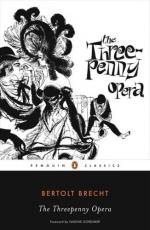|
This section contains 8,905 words (approx. 30 pages at 300 words per page) |

|
SOURCE: Elsaesser, Thomas. “Transparent Duplicities: The Threepenny Opera (1931).” In The Films of G. W. Pabst: An Extraterritorial Cinema, edited by Eric Rentschler, pp. 103-15. New Brunswick: Rutgers University Press, 1990.
In the following essay, Elsaesser argues in favor of The Threepenny Opera's merits as a great achievement in Weimar cinema despite a lawsuit filed against Pabst by Bertolt Brecht—the author of the opera upon which Pabst's film is based.
Preliminaries
To write about Pabst's The Threepenny Opera (Die 3-Groschen-Oper, 1931) is to venture into a minefield of received opinions. Even if one sidesteps the boobytraps of literary adaptations and refrains from debating the faithfulness of filmed classics, one ends up frying on the barbed wire of Bertolt Brecht's powerfully polemical defense of his intellectual property in The Threepenny Trial (Der Dreigroschenprozess). Finally, Pabst's ambivalent role within the Nazi film industry seems to weigh the arguments in favor of...
|
This section contains 8,905 words (approx. 30 pages at 300 words per page) |

|


